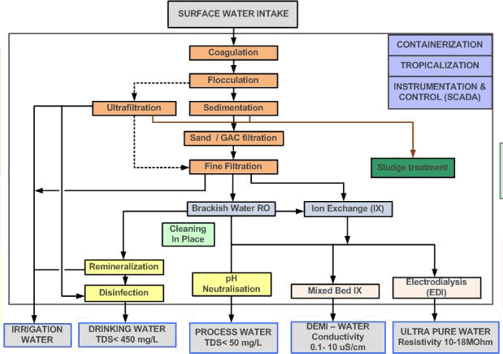Process-Surface water treatment
TYPE-SURFACE WATER


The removal of trace constituents may be required in certain reuse applications such as aquifer recharge, surface water augmentation, direct potable reuse, and in industrial applications. Advanced technologies currently being adopted for removal of trace constituents include membrane bioreactors, MF, UF coupled with NF and RO membranes, and advanced oxidation processes (AOPs) that allow treatment to the quality level fit for the intended use.
Surface water treatment processes
Due to the high cost of drinking water and the fact that water is not always available, more and more industries and municipalities use treated surface water. Normally the surface water needs to be treated before it has the required water quality. Surface water typically contains a high suspended solids content, bacteria, algae, organic matter, creating bad taste and odour. In some areas, like river estuaries, surface water can be brackish, reaching up to 8000 mg/L of salts.
Two processes are commonly used to treat surface water:
- Conventional treatment including clarification (coagulation/flocculation, sedimentation or dissolved air flotation), sand filtration, activated carbon adsorption and disinfection.
- Advanced treatment based on ultrafiltration technology.
Surface water treatment processes
Special attention is brought to disinfection since surface waters contain a wide range of coliforms (E.Coli), viruses and protozoa. The use of chlorine should be used with care since it reacts with natural organic matter to form disinfection by-products like trihalomethanes.







